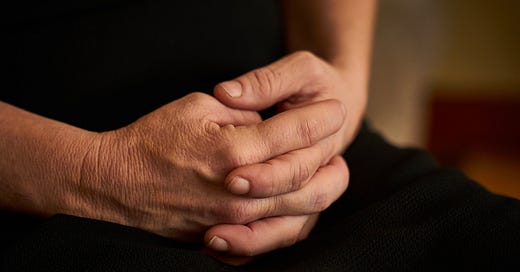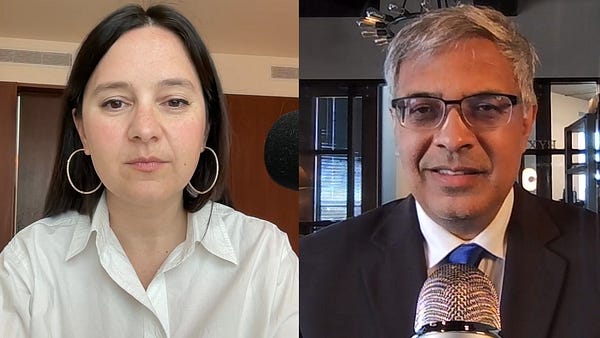
The Free Press

When he was 14 years old, Caroline’s son got a pharmaceutical implant in his arm that was supposed to help relieve his psychological distress. It was a puberty blocker called Supprelin, and it would continuously release a drug for about the next two years that would arrest further sexual development. Caroline, 43, had been queasy about approving this, but she was assured by the psychologist at the The Washington University Transgender Center at St. Louis Children’s Hospital that this was what her son needed—that it was the standard treatment for young patients experiencing discomfort with their sex.
Instead of providing relief, Caroline told The Free Press, her son experienced a devastating decline in his mental and physical health after this intervention. Among the side effects of Supprelin, according to a handout from the Transgender Center, are “mood changes, and weight changes.” The manufacturer’s website also lists “depression, including rare reports of suicidal ideation and attempt.”
Casey (not his real name) soon experienced all of these. Within a semester, Casey went from all As and Bs to a report card dotted with Ds and Fs. Many days he found it impossible to get out of bed. He missed so much school that it triggered an official meeting about his truancy that included a circuit court judge. He gained more than 30 pounds.
Most alarmingly, during one therapy session about seven months after he started the blocker, he told the center’s psychologist that he was having suicidal thoughts. She recommended he be immediately checked into the psychiatric ward at Children’s Hospital. When he came out, he was taking several drugs for depression and anxiety.
Caroline felt desperate and helpless, and she’d had enough. In June of 2022, she wrote an email to the clinic demanding immediate removal of the puberty blocker. The doctors in charge disagreed.
The Supprelin is still in Casey’s arm.
The Whistleblower
For many months, Caroline (we are withholding her last name for family privacy) has been deeply frustrated that her child was put on a powerful pharmaceutical and what happened to him subsequently. “I felt bullied,” she said of her interactions with the Transgender Center.
Then, on February 9, The Free Press published a story by Jamie Reed, a case manager at the center, about her four years working there. She gave a shocking account of the treatments young people with gender dysphoria received—treatments she described as “morally and medically appalling.”
The reaction was explosive. Missouri Attorney General Andrew Bailey, who had given Reed whistleblower protection in advance of going public, announced an investigation of the center. So did Republican senator Josh Hawley. Bailey called for an immediate moratorium on hormonal interventions on new patients, which Washington University rejected. The school released a statement saying, in part: “We are alarmed by the allegations reported in the article published by The Free Press describing practices and behaviors the author says she witnessed while employed at the university’s Transgender Center.”
Caroline read the story when her sister, a nurse, sent it to her. “My sister was bewildered by what was going on at the center and told me it was wrong,” Caroline said. Reed’s article described a process in which doctors pushed young people through a gender-affirming pipeline, quickly prescribing pharmaceutical interventions. There was little consideration of alternatives, or examination of the underlying mental health and social causes that might lead a young person to feel gender dysphoria.
“When I read it, I’m like—this is what happened to me!” Caroline said. “I felt validated. I felt: I knew it, I knew it.”
Following Reed’s story, and the announcements by Bailey and Hawley, the St. Louis Post-Dispatch wrote several stories critical of Reed. One quoted some parents who said that they were happy with the care their children received at the clinic, and that they were “baffled” by Reed’s descriptions.
Among the things the article failed to note is that several of the parents quoted are public advocates of youth transition. Journalist Jesse Singal reported on what was left out of the story, including the revelation that one mother who praised the center in the newspaper is a founder of a youth transition support organization. Not only is that organization linked on the center’s website, but this mother lobbied to get the center established.
Caroline has never spoken publicly about her son or her family’s ordeal. But when she read the Post-Dispatch article about the satisfied parents, she felt she had to speak out about how her experiences matched what Reed described. She eventually contacted Vernadette Broyles, a lawyer who represents Reed. A federal law known as HIPAA provides privacy protection regarding the release of certain patient information by health care providers. Caroline has given The Free Press permission to write about her child’s treatment and to have Reed discuss it.
Reed vividly remembers the case of Caroline’s son. It so disturbed her that she says “it was part of my decision to leave the center, and then to blow the whistle.”
Shifting Identities
I recently spoke to Casey via Google Meet with Caroline sitting in. Casey is charming, intelligent, and thoughtful. He enjoys the arts, participating in a range of musical extracurriculars. Due to the puberty blocker, he seems younger than his 16 years, with a hairless face and the voice of a young teen boy.
Casey expressed no discomfort with his sex as a child, but when he turned 13, he said, he discovered through friends and online that “transgenderism was a thing.” He started researching this and felt, “Holy crap! You can do that?” Soon he declared he was “gender fluid.” Casey explains, “This means that my gender changed based on the day. Then it got to the point where I was never feeling masculine or like a boy.” After about six months of being gender fluid, Casey says, “I decided that I was a fully transgender girl. Like I wanted to present as a girl and I wanted people to see me as a girl. So, I started to socially transition. I was going by a different name and using she/her pronouns.”
That lasted for a few more months until, he says, “I started to lean more kind of in-between. I didn't identify as a girl as much. But I did not see myself as a boy, so I identified as non-binary, which is what I am today.” He explains being non-binary means he is neither sex, and to go along with this he changed his name again—to something as gender neutral as “Casey”—and began using they/them pronouns. (Because Caroline calls Casey her son, and for the sake of clarity, we are using male references for Casey.)
His mother was low-key about these shifting identities, and told him he didn’t need to label himself as anything at this point in life. Caroline says she encouraged Casey to “just be who he is, without having to put a name on it.”
Although he declared himself to be neither sex, puberty was declaring otherwise. His father thought counseling would help, and he wanted Casey to see someone in tune with LGBTQ issues, and eventually discovered the Transgender Center. By then Casey had already done research on something he heard about from a friend: puberty blockers. Casey arrived at the center with the agenda of stopping his puberty from progressing.
Caroline assumed counseling at the center would help Casey sort things out. But in retrospect, she says, what the psychologist at the center did was solidify the idea that Casey needed medical intervention for his gender distress. (Washington University did not respond to requests for comment.)
Banking Sperm
A family meeting arranged by the center occurred on July 14, 2021. Casey, then 14, and his parents met with the clinic’s psychologist. Her recommendation was that Casey get the Supprelin implant. But Caroline was confused about why her son needed to halt his normal development at all.
“He was trying to find an identity, cycling through a few of them at a pretty fast rate,” she says. “Why rush him into a medical intervention instead of seeing if he’s going to continue with these changes?”
The parents were given a two-page handout describing the possible side effects of the treatment. These included long-term effects on bone density; body aches and sleep disturbance; abnormal heartbeats and seizures; mood and weight changes. There were two sentences about fertility: “Blocking pubertal hormones and transitioning on to gender-affirming hormones may have long-term effects on fertility. If a patient is interested in fertility preservation, a meeting with a fertility doctor should ideally be done prior to hormone blockers and/or gender-affirming hormone therapy.” (Emphasis in the original.)
The psychologist then addressed the family to make sure they understood that Casey might end up infertile. When Caroline expressed concern about this, Casey reassured her that he didn’t want children. She asked what if he changed his mind later. “I’ll adopt,” he replied.
Caroline was becoming more disturbed by how the therapist seemed to gloss over the enormous implications of the decision in front of them. “She said that if future fertility was a concern, we could look into banking his sperm before the blocker went in,” Caroline said. She recalls wondering how she found herself in a conversation about banking the sperm of her 14-year-old. “It was weird, and I didn’t like where this was going. It was just so overwhelming.”
Reed says what Caroline describes is not appropriate care. For one thing, she says, “No parent should feel pressured. That is not true informed consent.” For another, she says, when children are faced with the prospect of sterilization and say they’ll adopt, that should be a red flag. “This says someone is still thinking about becoming a parent, and that means you have to stop and say we need to get real counseling about reproduction.”
Caroline had hoped that at least part of the meeting would be among the adults, so they could talk more freely. But she said she had to share her doubts about the treatment in front of her son. She was aware that kids diagnosed as transgender, after having their puberty blocked, generally go on to transition medically. This means getting hormones of the sex they wish to be, and possibly surgery. But as she told the group, “I’m not going to approve him getting a feminizing hormone, and the blocker only lasts about a year and a half, so then he will have to go through puberty anyway. Why would we do this?”
Caroline says the answer from the therapist was, “Well, it’s what Casey wants, and we want Casey to feel comfortable.” Caroline says it felt as if Casey was leading the meeting.
Casey’s father was ready to approve the blocker, but because they had joint custody, and Caroline refused to consent, her veto stood.
But two months later she got a phone call from a nurse at the center who wanted to reopen the discussion. Caroline says, “Casey was about to turn 15, and I didn’t know what to do. He had been struggling with depression and anxiety, and they were saying the reason why is because he feels like he’s not in the right body. And I thought, if this is going to make him happy, let’s just give it a try. The worst it would be doing is stopping his hormones and it can be taken out and puberty will take place like it was supposed to.”
Caroline sent her emailed consent. “I thought, let’s see what happens. And what happened was that everything got worse.”
Do You Want a Dead Son or a Live Daughter?
Suicide is an ever-present topic at the Transgender Center. In a video interview with The Free Press, Jamie Reed said clinicians at the center commonly warned parents—in front of their child—that refusing to give consent for gender transition could lead to that child’s suicide. Normalizing, even glorifying suicide by saying it is a common outcome for young people who are not allowed to medically transition, violates all established rules for how to talk safely about a subject known to have a substantial element of social contagion.
Meanwhile, evidence shows that the threat of suicide in these circumstances is exaggerated. This medical journal article by Oxford University sociologist Michael Biggs illustrates how hyperbolic this threat is. Between 2010 and 2020 he found that 0.03 percent of patients at the UK’s Gender Identity Development Service committed suicide. He writes, “The fact that deaths were so rare should provide some reassurance to transgender youth and their families. . . . It is irresponsible to exaggerate the prevalence of suicide. Aside from anything else, this trope might exacerbate the vulnerability of transgender adolescents.”
But Caroline’s discussions with the center’s staff fit Reed’s description of how not to talk about suicide.
Caroline told me that when she expressed resistance to starting Casey on blockers, the psychologist responded by quoting alarming statistics, in front of Casey, on gender dysphoric kids committing suicide if they aren’t allowed to transition. “I was flabbergasted, and I really felt like this is not a meeting for me to get answers to my questions, and for everybody to have equal say,” she said. “This is like I’m the last man standing and now it’s being implied that if I don’t okay this, I don’t care if my kid kills himself.” She said she felt as though “the therapist was planting the idea for him right there.” (As for Casey, he says he was treated “amazingly” at the center. Of the therapist he says “she was a friend to me and offered a great amount of support.”)
A Dramatic Slide
The slide in Casey’s mental health after receiving the blocker was not just evident to his mother. As Reed wrote to her colleagues, “I have been monitoring this chart. . . and I have been following the mental health worsening in [the psychologist’s] visit notes.”
Then, during a counseling session in April 2022, Casey told the psychologist he sometimes thought of suicide, and had a plan for how he would do it, but that he didn’t have an intention to try. Alarmed, the psychologist recommended that Casey be immediately admitted to the psychiatric unit of Children’s Hospital, known as the Behavioral Health Unit. After a few days as a patient, Casey asked to return home (he lives primarily with his father). He made it clear to his parents that his talk about suicide was just that—talk.
Caroline expected that after this event, people at the center would focus on the role the puberty blocker might be playing in Casey’s continued mental health decline. But they weren’t. Reed was stunned by the lack of care. She said, “We initiated a blocker, the child’s mental health is getting worse—the psychologist sees it’s getting worse—and there is no discussion as to whether this intervention is working the way it was supposed to, and does it need to stop.”
On June 9, Caroline had had enough. She decided it was time to get the blocker in her son’s arm removed. She sent this pointed and angry email to the clinic:
“Please be advised that I’m revoking my consent for this course of medical treatment. Grades have dropped, there’s been an in-patient behavioral health visit and now he’s on 5 different medications. Lexipro [sic], Trazadone [sic], Buspar, etc. [Casey] is a shell of his former self riddled with anxiety. Who knows if it’s because the hormone blockers or the other medications. I revoke my consent. I want the hormone blocker removed. Thank you.”
A few hours later—having heard nothing—she sent a follow-up:
“I also do not want [Casey] to receive anymore counseling at the Transgender Center. He’s not transgender. He’s a 15 year old child. The only further treatment I authorize as JOINT LEGAL GUARDIAN is the removal of the puberty blocker and the subsequent aftercare. Please call me with any questions.”
Reed says that when a mother with joint legal custody demands an end to treatment that is harming her child, that treatment should be stopped right away. But that’s not what happened. Instead, Reed says, the discussion within the clinic was how to keep the blocker in place. In the end, the doctors called for a consultation with a hospital ethicist. It was conducted on Zoom, with Reed attending. She walked away from it thinking, “Our center is an ethical hot mess.” The ethicist seemed to agree. Reed says as the doctors described the case, the ethicist repeatedly responded, “Wait, you’re doing what?”
In response to Caroline’s demand for the removal of the implant, she said someone from the center asked for a copy of her custody agreement and parenting plan. “I definitely felt like I was getting the runaround,” Caroline said. She noted she wasn’t asked for such documents when they sought her permission to have the Supprelin put in her son’s arm.
A few weeks later, a meeting took place at Children’s Hospital with the family, the center’s psychologist and a nurse practitioner to discuss the blocker. Caroline was moving that day and was supposed to be put on speaker phone. But she never got a call. She found out much later from Casey that the center’s position was that in a joint custody arrangement one parent could not unilaterally demand the removal of the blocker. That meant everyone but Caroline was in favor of keeping it in, including Casey’s father.
I asked Casey why he thought his father supported this decision while his mother opposed it. “He was more concerned with what would make me happier,” Casey said. “My mom was more concerned about the future and my dad was more concerned about how I felt.”
In Reed’s story for The Free Press, she described how when parents disagreed about their child’s treatment, the center would make things difficult for the objecting parent, especially in the case of divorce. That was playing out with Caroline. If she was to have any chance of getting the blocker removed, she decided she needed an attorney. She spoke to one briefly, but ultimately concluded it would be too hard and expensive to try to press her case.
The lawyer did have a suggestion: why not take Casey to his regular pediatrician and ask to have her remove the implant? Caroline did. But even though the pediatrician was sympathetic, she said she was not in a position to remove a device placed by another doctor.
When Reed was informed of this, she said, “That just sickens me. I just can’t imagine how powerless you would feel as a parent in that moment. To feel you have to go up against this monolithic medical institution, having no money for an attorney, and feeling bullied to start with.”
What’s Next?
A puberty blocker can’t stay in forever, and Casey’s is scheduled to come out in July—more than a year after Caroline demanded it be removed.
Casey is resigned to the removal and normal puberty re-starting. He says of his mother’s position, “Her concerns are valid.” This includes, he says, “the possibility that the hormone blockers have affected my mental health. Because my mental health has decreased a lot since starting them.” But Casey also said his mental health had been declining since the pandemic.
Casey says he is trying to accept what will come after the blocker is removed. “I do feel I come off a bit childish, because I do look younger,” he says, adding that’s fine with him. He doesn’t want to look like his male classmates, with their facial hair, Adam’s apples, and broadening shoulders. “It is a struggle for me, because there’s a lot of uncertainty with the changes that I’ll have to go through. It's just kind of scary.”
Caroline remains mystified that the Transgender Center, instead of helping her son face his fears about entering adulthood, instead offered him a way out. She recalls her own puberty. “When my period started, I wanted a way to have that not happen again. It was traumatizing,” she said. “If I had had an option to get out of it, I would have. But it’s nature. There’s a reason it happens.”
She says Casey’s concerns are common for kids his age and not an indication of something that needs pharmaceutical intervention. “There’s no precedent for this type of treatment. How do they know this is the right answer? How do they go to this extreme?” she asks.
I spoke to Dr. William Malone, an endocrinologist and a board member of the Society for Evidence-Based Gender Medicine about the use of puberty blockers in young people. He says we don’t know enough about their long-term effects. “A child on blockers is halted in physical and likely emotional maturity,” he said. “Within a year or two, their peers will be profoundly different, and they become out of sync. Puberty is not just a physical event, it’s a psychosocial event with your peers. There is brain development that occurs. Blocking puberty likely has important implications for functionality as an adult.”
Of course, none of this shows up on the two-page handout from the center describing the side effects of blockers.
Although Attorney General Andrew Bailey’s investigation into the Transgender Center is not completed, on March 20 he announced that, based on his discoveries so far, he will be promulgating an emergency regulation to stop treatments there that “lack clinical evidence of safety or success” in order to “protect children from being subject to inhumane science experiments.” His proposed new guidelines include requiring extensive and comprehensive mental health care assessment and treatment before any gender intervention can be started, and mandate that all patients be tracked for adverse effects for 15 years.
“These are common sense things all parents should want for their kids,” Reed says of the new standards. “If this care is going to continue, these guardrails have to be in place.”
“I don’t think kids should make lasting decisions when they don’t have the capability to do so,” Caroline says. She adds that if her son ultimately wants to transition, she hopes he waits until he’s about 25, when his brain has matured and when he’s had some life experiences. “If he wants to be a female later on, I don’t have a problem with that. He just should do it when he’s an adult.”
If Casey comes off the blocker this summer and goes through natural puberty, he will be a most unusual pediatric gender clinic patient. Dr. William Malone says, “We know that more than 95 percent of kids on puberty blockers go on to cross-sex hormones.”
Caroline hopes that her family can find the right help to undo the effects and side effects of the center's treatment. She says, “My son needs the antidote to this whole therapy. I feel like he needs a licensed therapist, an endocrinologist, people who can see him through the recovery from this. It’s going to be physical and mental. And then we need family counseling, because this whole thing has torn us apart.”
This piece has been updated with further comment from Casey.
If you have a tip or a story for us, please write to tips@thefp.com.
Investigative stories like this one take time and investment. If you believe in the kind of journalism we do, please become a subscriber today:
















Seeing as this article revolves around the mother's feelings and not the actual patient, I searched online to see if I could find out more from the viewpoint of the kid. Color me shocked (not really) to find out that, allegedly, this article was published against the child's wishes, and that it doesn't faithfully portray their account of things. (I'm not really shocked because TFP has established a pattern of publishing articles that contribute to the marginalization of trans people.)
If TFP actually wants to live up to their promise of "transparency, honesty, and integrity," then they should probably give this kid a chance to tell their side of this story. If TFP is really about "getting to the truth," then that would be appropriate, right?
These “gender-affirming” medical practitioners are using the same high pressure sales techniques as the worst used car salesmen. Their fear-mongering combined with lies of omission and commission are only to score a sale, regardless of the irreversible horrors inflicted on the customer.
We owe so much to Bari and Nellie and the FreePress team for their courage and commitment.